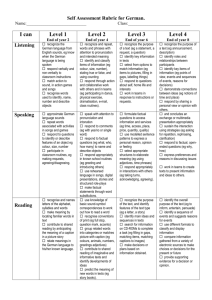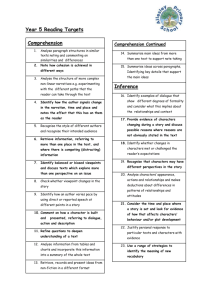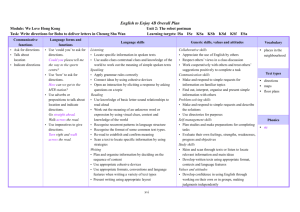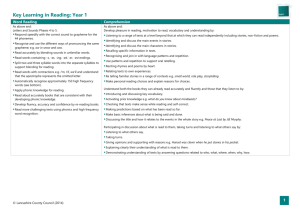Ich kann lernen. Ich kann Deutsch. Self Assessment Rubric for German
advertisement
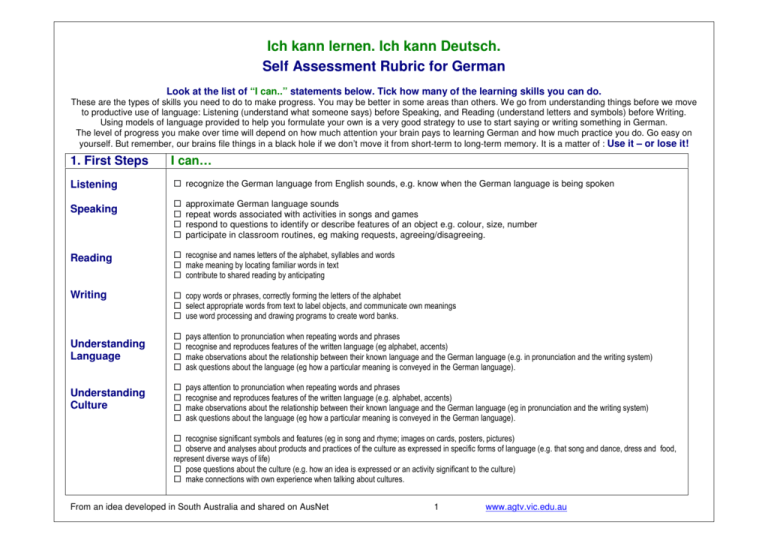
Ich kann lernen. Ich kann Deutsch. Self Assessment Rubric for German Look at the list of “I can..” statements below. Tick how many of the learning skills you can do. These are the types of skills you need to do to make progress. You may be better in some areas than others. We go from understanding things before we move to productive use of language: Listening (understand what someone says) before Speaking, and Reading (understand letters and symbols) before Writing. Using models of language provided to help you formulate your own is a very good strategy to use to start saying or writing something in German. The level of progress you make over time will depend on how much attention your brain pays to learning German and how much practice you do. Go easy on yourself. But remember, our brains file things in a black hole if we don’t move it from short-term to long-term memory. It is a matter of : Use it – or lose it! 1. First Steps I can… Listening recognize the German language from English sounds, e.g. know when the German language is being spoken Speaking Reading recognise and names letters of the alphabet, syllables and words make meaning by locating familiar words in text contribute to shared reading by anticipating Writing copy words or phrases, correctly forming the letters of the alphabet select appropriate words from text to label objects, and communicate own meanings use word processing and drawing programs to create word banks. approximate German language sounds repeat words associated with activities in songs and games respond to questions to identify or describe features of an object e.g. colour, size, number participate in classroom routines, eg making requests, agreeing/disagreeing. Understanding Language pays attention to pronunciation when repeating words and phrases recognise and reproduces features of the written language (eg alphabet, accents) make observations about the relationship between their known language and the German language (e.g. in pronunciation and the writing system) ask questions about the language (eg how a particular meaning is conveyed in the German language). Understanding Culture pays attention to pronunciation when repeating words and phrases recognise and reproduces features of the written language (e.g. alphabet, accents) make observations about the relationship between their known language and the German language (eg in pronunciation and the writing system) ask questions about the language (eg how a particular meaning is conveyed in the German language). recognise significant symbols and features (eg in song and rhyme; images on cards, posters, pictures) observe and analyses about products and practices of the culture as expressed in specific forms of language (e.g. that song and dance, dress and food, represent diverse ways of life) pose questions about the culture (e.g. how an idea is expressed or an activity significant to the culture) make connections with own experience when talking about cultures. From an idea developed in South Australia and shared on AusNet 1 www.agtv.vic.edu.au 2. Next steps I can… Listening recognize and repeat, words and phrases with attention to pronunciation and intended meaning identify and classify items of information (eg colour, size, number), stating true or false, and using counting respond through action and collaborative work with others and in teams (eg participating in dance, physical exercise, dramatisation, e-mail, class routines). Speaking speak with attention to pronunciation and intonation respond to comments (e.g. with yes/no or single word) respond to factual questions (e.g. what, who, how many) to name and describe objects respond appropriately in known school routines (e.g. greeting and introducing others) use rehearsed language in songs, digital presentations, stories and structured role-plays make factual statements through word substitutions. Reading use knowledge of basic sound-symbol correspondences to work out how to read a word recognise conventions of print (e.g. full stop, question mark, accents) group related words into categories or matches picture with caption (e.g. colours, animals, numbers, greetings adjectives) contribute to shared reading of imaginative and informative texts and identify developments of ideas predict the meaning of new words in texts (e.g. story books). Writing correctly forms letters and words when selecting words from charts or texts communicate ideas and information through sequencing a set of words to make own meaning in a phrase or a sentence describe items using colour, number, shape and size of items use different formats to convey meaning (e.g. captions, speech bubbles) write an informal letter, e-mail or card using model texts, and electronically requests or respond to queries for information. Understanding Language apply concepts of word formation and correctly forms sounds and words in communicating information through speech and writing (eg punctuation and phrasing, compound words) recognise ways text is presented according to purpose (e.g. as captions, labels, animations, dialogues, vocabulary charts, greeting cards, calligraphy) recognise conventions in written and spoken texts (e.g. messages, posters, exclamations, commands) identify language forms used (eg for specifying, counting, identifying and describing objects and actions, and time and place; for stating ownership and asking questions) recognise the ways cultural values are expressed in language (e.g. gender, formality) use available textual resources to decipher and compare meaning and construct their own texts. Understanding Culture observe the significance of particular cultural practices in their own language activities identify and analyses expressions of cultural identity in language (e.g. in stories, social conventions and etiquette) observe concepts related to cultural values in language (e.g. how titles, personal names, family relationships, ways of greeting are expressed) observe the significance of concepts within cultural practices (e.g. time, history, the cycle of the seasons and the environment) interacting through online sources of information. From an idea developed in South Australia and shared on AusNet 2 www.agtv.vic.edu.au 3. More steps I can… Listening recognize the purpose of a text (e.g. a statement, a request, a question) identify key information in texts select from options to match information (eg items to pictures, filling in gaps, labelling things) respond to questions about self, home life and interests work in teams in response to instructions or requests. Speaking formulate factual questions to access information and services (e.g. time, access, place, price, quantity, quality) use modelled sentence patterns to express a personal reason, opinion or feeling select appropriate structures to elaborate meaning (e.g. using adjectives, time phrases) respond appropriately in interactions with others (e.g. taking turns, acknowledging, agreeing). Reading recognize the purpose of the text, and identify features of the text type (e.g. a letter, a story) identify main ideas and sequences in texts search for information on CD-ROMs to complete a task (e.g. filling in gaps, matching items, matching captions to images) make decisions or plans based on information obtained. Writing use models to apply text conventions (e.g. title, heading, letter format) order words correctly in simple statements (e.g. actions, descriptions, using numbers, questions) link ideas using connectives (e.g. and, but, also, because) use available resources to access new vocabulary and extend the message use appropriate interactive CD-ROMs and word processing software to construct texts and share information with others. Understanding Language decipher meaning of new words using contextual knowledge apply linguistic structures to extend their own meaning (e.g. time markers, adverbs, adjectives) recognise how questions and statements are formed make comparisons with known language to identify and describe patterns and features of the language Understanding Culture relate aspects of culture, language and identity in texts (e.g. forms of address) identify and reports on patterns of interaction and behaviour in everyday life over time (e.g. relationships between people) identify the significance of concepts in how meaning is conveyed (e.g. manners, respect, politeness) recognize connections between the values and practices across cultures. From an idea developed in South Australia and shared on AusNet 3 www.agtv.vic.edu.au 4. Yes you can! I can… Listening • • • • • recognize the purpose of a text (e.g. announcement, description) identify roles and relationships between participants identify key items of information (e.g. points of view, events and sequences of events, reasons for decisions) demonstrate connections between ideas (e.g. notions of time and place) respond by sharing a personal view or opinion with others. Speaking • • • • • Starts and concludes an exchange or multimedia presentation appropriately sustain the interaction using strategies (e.g. asking for repetition, rephrasing, clarification) respond to factual, open-ended questions (e.g. why, how) express preferences and reasons in discussing issues work in teams to create texts to present information and ideas to others Reading • • • • identify the overall purpose of the text (e.g. to inform, entertain, persuade) identify a sequence of events and suggests reasons for events use different formats to classify and display information compare information gathered from a variety of electronic sources to make choices or decisions for the present or future provide supporting evidence for a decision or opinion. Writing • • • • • use text conventions as appropriate for the purpose structure ideas to form a cohesive text, and demonstrates a logical sequence extend or elaborate the message using (e.g., comparison or contrast) express personal opinion on issues, drawing on a range of electronic sources of information use imaginative or expressive language to inform or entertain others • • • • recognise and employs conventions of speech and writing when addressing different audiences apply structures to elaborate or extend the message identify connections between language and cultural practices of the language make comparisons between languages to explain aspects of the German language system • • • • • identify generalisations about the culture (e.g. questioning stereotypes in texts) analyse and discuss ways in which cultural values are presented in texts (e.g. in metaphor, register) reflect on the ways culture is interpreted by others (e.g. identifying how stereotypes influence perceptions) explain why particular practices and products are evident and valued in the culture (e.g. aspects of faith, seasonal celebrations) reflect on own values and identity in expressing opinions about culture and how these have changed over time. Understanding Language Understanding Culture . The steps don’t end here, but if you can do all these, then you have developed a sound set of intercultural language skills. From an idea developed in South Australia and shared on AusNet 4 www.agtv.vic.edu.au

